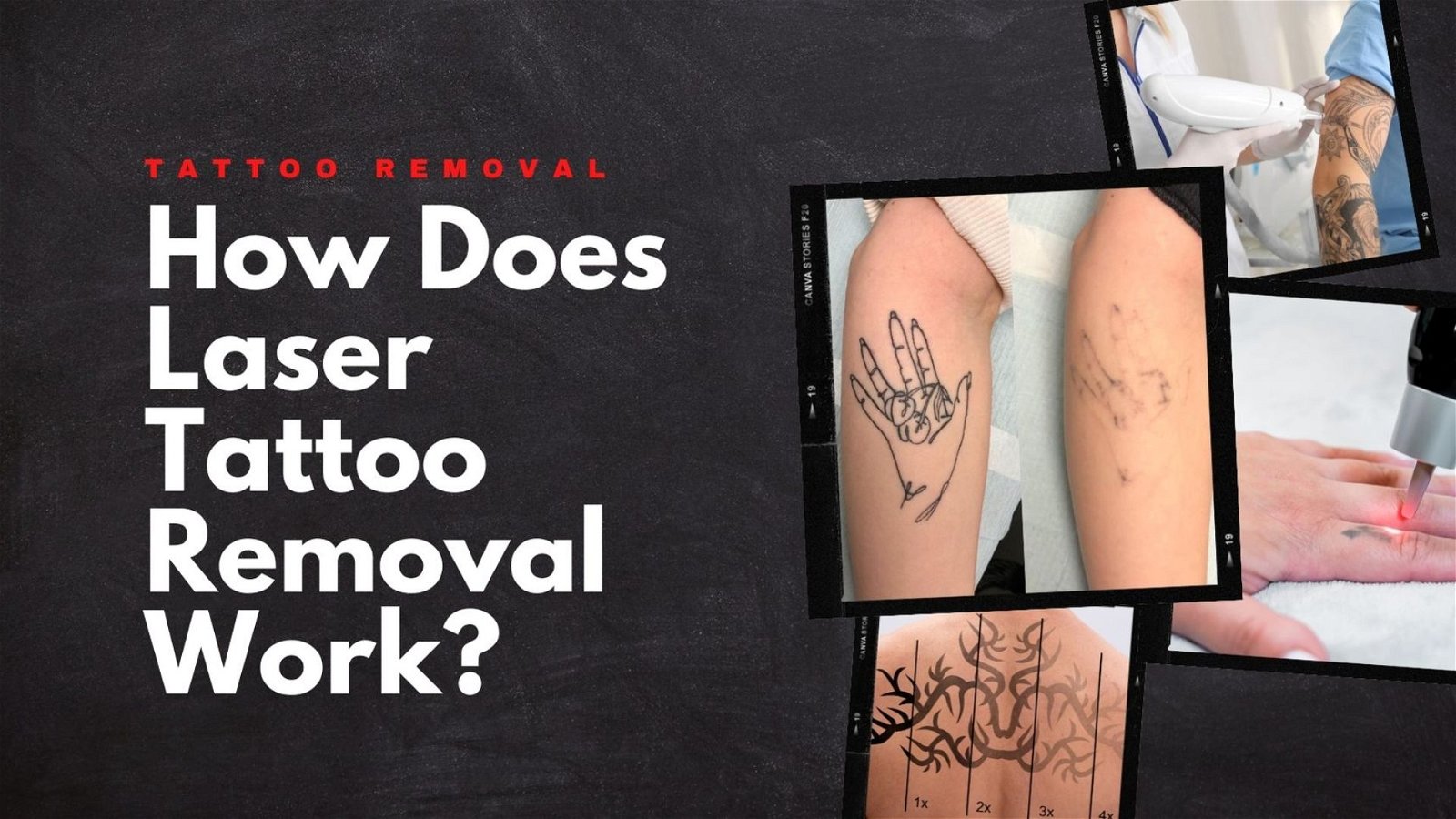There are loads of reasons why you may want to find out if laser tattoo removal works. Maybe you want to remove a tattoo that brings around bad memories, or maybe you’re struggling to land a job with a prominent public-facing tattoo.
You’ve probably heard of laser tattoo removal, but is it the best removal method for you? There are four methods of tattoo removal that are ‘common’, but how good is laser tattoo removal and is it the method for you?
Laser Tattoo Removal is here to save the day. But how does it work? Read on to find out!
What Is Laser Tattoo Removal?
Laser Tattoo Removal is a process where a laser produces pulses of light to break down ink pigments in a tattoo.
The light energy penetrates the skin and is absorbed by the tattoo ink. The light energy causes the ink to fragment and break down into nanoparticles.
The body’s immune system will then start to clear away these tiny fragments over time, lightening the tattooed area.
Types of Laser Used To Remove Tattoos
Laser tattoo removal is a process that uses laser energy to break down the ink in tattoos. The laser energy is delivered through the doctor’s handpiece over the tattoo. The laser passes through the skin and is absorbed by the ink, breaking down into nanoparticles. The body’s natural cleansing process then eliminates these small pieces.
Four types of laser can be used for tattoo removal:
Q-Switched Nd YAG Laser
This type of laser is used most often for tattoo removal. It operates at 1064nm and works well in removing black and dark blue inks. Potential hyperpigmentation is a risk but not common.
Q-Switched Ruby Laser
This type of laser operates at 694nm and is best for removing red ink tattoos. This laser type can cause scarring, skin discolouration, and texture changes like bumps or blisters.
Q-Switched Alexandrite Laser
It operates at 755 nm and is the best for removing green, black, and blue tattoos. Can cause changes in texture and transient hypopigmentation.
Picosecond Laser
The newest type of laser uses shorter pulse lengths. The shorter pulses lead to quicker healing and can be more effective in removing tattoos.
It works best on black, green, and blue inks but can also be used for red, orange, and purple. May cause mild blistering skin discolouration.
How Many Sessions Will I Need?
The number of sessions needed to remove a tattoo ultimately varies depending on the tattoo’s size, colour, and age.
Most tattoos require 7 to 10 treatment sessions, but some may need more or less depending on the ink used and how deep it is in the skin.
It is important to note that the number of sessions needed will vary from person to person. So, it is best to consult with a medical professional to estimate the number of sessions required and the total cost.
Factors Affecting Laser Tattoo Removal
Several factors affect how many laser treatments are needed to remove a tattoo:
Size of Tattoo
The tattoo’s size will significantly determine how many treatments are required. The larger the tattoo, the more treatments are needed.
Colour of Tattoo
Since one laser cannot remove all ink colours, the tattoo’s colour will also factor. The darker the ink, the easier it will be to remove.
Age of Tattoo
The older the tattoo, the easier it will be to remove. As tattoos age, some ink pigments have already faded over time.
Location of Tattoo
The location of the tattoo will also be a factor. Tattoos on areas like the face or neck will be easier to remove than tattoos on the arms or legs because these body parts have larger blood vessels.
But it’s important to note that there is a higher risk for skin discolouration and scarring because of the skin’s sensitivity in your face, neck, and some other body parts. That’s why medical experts prefer more removal sessions for tattoos in these areas to minimise the risk.
Type of Tattoo
An amateur tattoo will be easier to remove because it is not deeply embedded into the skin. On the other hand, professional tattoos will be more difficult to remove because the ink is inserted deeper into the skin.
How Much Does Laser Tattoo Removal Cost?
The laser tattoo removal cost will vary depending on the tattoo’s size, colour, and age.
Generally, the cost will range from $200 to $500 per session. For face tattoos, sessions can range from $700 to $1,000.
Risks Associated With Laser Tattoo Removal
Although laser tattoo removal is a safe and effective procedure, some risks are associated.
Some of the risks include:
Scarring
The use of laser energy can cause scarring in the treated area. Scarring is common in areas where the skin is thin, like the face and neck.
Infection
The use of a laser can also increase your risk for infection. It is vital to keep the area clean and dry after treatment.
Hypopigmentation
The use of laser energy can also cause hypopigmentation or the loss of skin colour. This is more common in darker-skinned patients and can be permanent.
Hyperpigmentation
Laser tattoo removal can also cause hyperpigmentation or the overproduction of melanin. This is more common in lighter-skinned patients and can be permanent.
Blistering
The use of laser energy can cause blisters in the area being treated. Blisters are usually temporary and will heal on their own.
Pain
It is expected you’ll experience pain during laser tattoo removal and after the treatment. The level of pain will vary from person to person.
Swelling
The use of laser energy can cause swelling in the treated area. This is usually temporary and will go away after a few days. If this symptom persists days or weeks after your treatment, it is best to consult your doctor.
Redness
The use of laser energy can cause some redness in the treated area. This is usually temporary and will fade over time.
If you consider laser tattoo removal, it is essential to discuss the risks and benefits with your doctor.
What To Prepare Before Your Laser Tattoo Removal Session
Before your laser tattoo removal session, you will need to:
- Avoid sun exposure. It is crucial to avoid sun exposure before and after your treatment. The sun can increase your risk for scarring.
- Stop using Retin-A or any other medication that can make your skin sensitive to light. If you use Retin-A or any other medicines that can make your skin sensitive to light, you will need to stop using it at least two weeks before your treatment.
- Shave the area that is being treated.
- Arrive rested and hydrated.
What To Expect After Your Laser Tattoo Removal Session
After your laser tattoo removal session, you will need to
- Avoid sun exposure. It is crucial to avoid sun exposure after your treatment. The sun can increase your risk for scarring.
- Avoid swimming. It is also important to avoid swimming after your treatment. Water can increase your risk for infection.
- Use a sunblock with SPF 30 or higher. It is important to use a sunblock with SPF 30 or higher after your treatment to avoid any damages caused by sun rays.
- Wait for the area to heal before applying any makeup. It is important to wait for the site to heal before applying any makeup to avoid contaminating the exposed area.
- Avoid working out. It is also important to avoid working out after your treatment. Sweat can increase your risk for infection.
- Experience some pain and swelling. You will experience some pain and swelling after your treatment. This is normal and will go away after a few days.
- Apply antibiotic cream within 24 hours to avoid the risk for infections.
Final Thoughts
If you consider laser tattoo removal, it is important to discuss the risks and benefits with your doctor. While the laser can effectively remove tattoos, it also comes with risks. It is important to weigh these risks against the benefits before deciding if this treatment is right for you.
Laser tattoo removal procedures are typically between 7 to 10 sessions. Remember that the number of sessions will depend on several factors like colour, location, and size. The more sessions you have, the better chances of eradicating the tattoo.
It is essential to follow your doctor’s instructions after your treatment. This includes avoiding sun exposure, swimming, and working out. You will also need to apply antibiotic cream within 24 hours of your session.
Remember to avoid sun exposure before and after your treatment and wait for the area to heal before applying any makeup.
Sources:
- Laser Tattoo Removal Sessions
https://www.ncbi.nlm.nih.gov/pmc/articles/PMC4411606/





